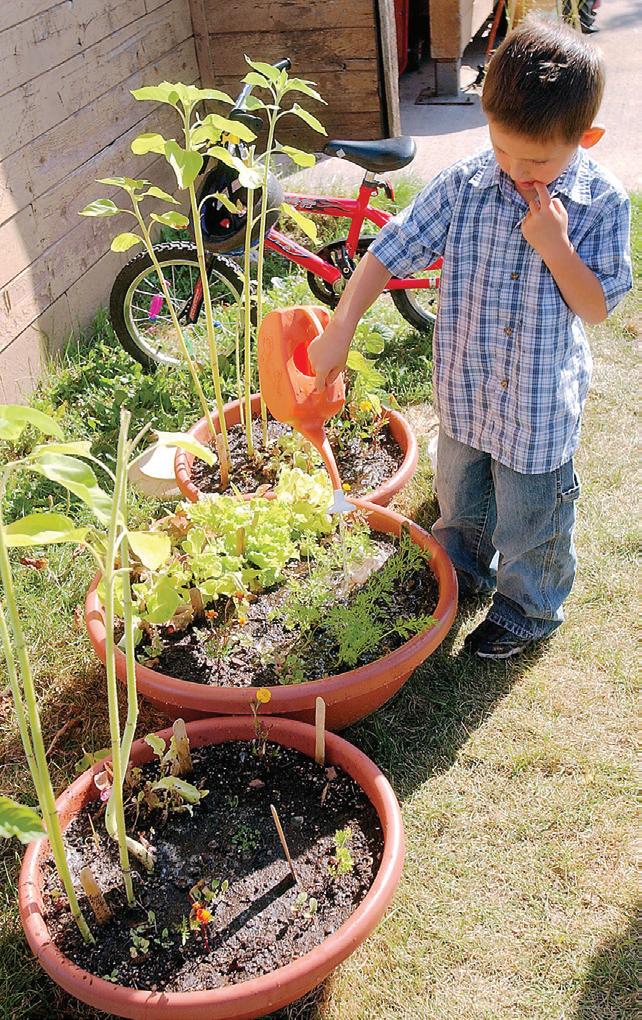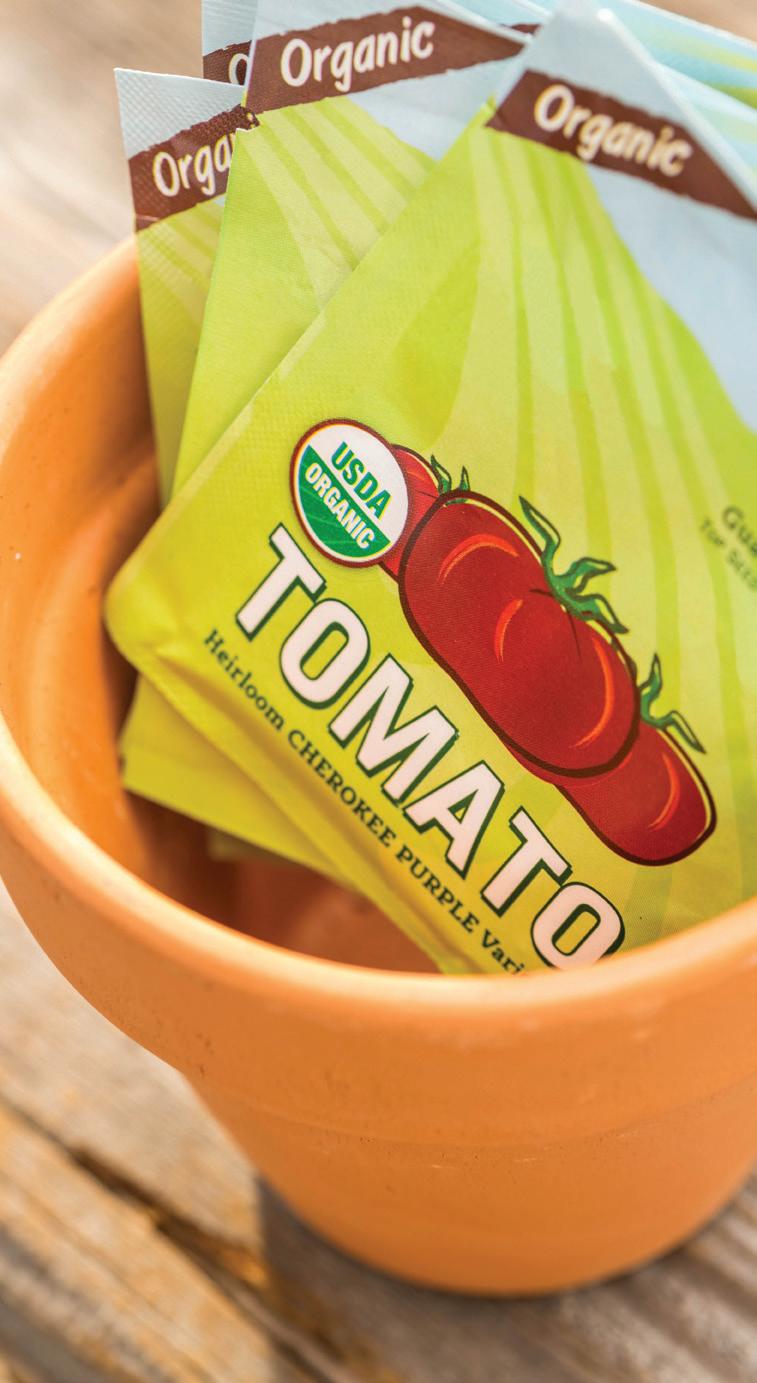
5 minute read
Children’s journey with food begins in the garden
BY ALI WADE
Gardening with kids is a great way to teach them where their food comes from, but also to encourage them to try healthful options, learn valuable life skills, oh — and to have fun!
Here are just some of the benefits of teaching kids to garden:
Improved focus: Healthy activity, fresh air and green spaces can lead to improved focus. A significant body of research (including a study by the National Center for Biotechnological Information) exists supporting the idea that when kids interact with nature, they are less restless and more able to concentrate and control impulses. Experiential learning / problem solving: When kids care for plants, they are directly witnessing the effects of problems such as having too little water or too much sunlight. They learn to employ problem-solving skills to remedy these issues. They also get to see the “magic” of science in action!
Creativity: At each stage, from choosing their seeds to designing their garden, to harvesting and serving their fruits and veggies, kids get to make choices and express themselves creatively.
Builds confidence / selfesteem: Through gardening, kids experience the satisfaction of producing something useful to the people in their own home: food! The sense of pride they get from a gardening success is a wonderful benefit.

Fun: What’s more fun than eating something you grew yourself?
Plot Gardening
If you have access to growing space, this is a great way to garden, because it’ll get you and the kids outdoors to enjoy the sunshine and fresh air. You’ll also give your kids an opportunity to see the interdependence of plants in a biodiverse environment. Kids will see for themselves the effects of weather conditions and insects on their plants, as well as witness the natural life cycles of those plants.
Some plants require a head start. Involve kids in a project starting seeds indoors until temperatures warm up (this is a common practice for gardeners and a necessity for our climate).
Your hardiness zone will determine when you need to start indoor seeding and when you can transplant seedlings outside. In our region, the safe planting window is typically between May 15 and June 15, with some exceptions, as long as hard frosts are not occurring. Older kids may enjoy learning about the effects our region’s greatest feature, Lake Superior, can have on our weather, and why gardening zones closer to the lake differ from zones farther away from the lake’s effects.
If you don’t want to plant from the seed, you can purchase plants as “starts” from the co-op or local greenhouses and plant them directly once it is warm enough. This year, the co-op will offer a variety of vegetables, herbs and flowers grown by John Beaton and Emily Darnell at Fairhaven Farm just north of Duluth.
Fairhaven Farm does not use pesticides, herbicides or other chemicals. They also do not use any neonicotinoids (chemicals that affect bees’ central nervous system), so they are a bee-friendly choice.
Most importantly, help kids to choose items that are fun to watch grow, are easily grown in this climate, and taste good!

Container Gardening
If you don’t have the space for plot gardening, container gardening is a good option. You don’t need a lot of space to let kids experience the fun and satisfaction of growing foods that can be used on your family table. Herbs are perfect for a container garden and kids will love the smells and flavors that herbs produce. Try basil, cilantro or dill to get them started.

A space as small as your window sill is all you really need to plant something that your kids can care for, watch grow and enjoy! — MDT
Ali Wade is the brand manager for the Whole Foods Co-op. She wrote this for Moms & Dads Today.
What should be planted outdoors when danger of frost has passed:
• Beans
• Peas

• Carrots
• Beets
• Cilantro
• Radishes
Plants to grow from seed indoors and later plant outside as “transplant”:

• Tomatoes

• Peppers
• Corn
• Broccoli
• Brussels sprouts
• Cabbage
• Cauliflower
• Eggplant
• Kale Lettuce
• Chard
• Squash*
• Melons*
• Onions
• Leeks
Chives and some herbs, such as basil, parsley, sage, mint, oregano, thyme, rosemary, and lavender. Also, flowers such as pansies, violets, asters, marigolds, zinnias and cosmos.
*must be carefully-transplanted
10 Steps To Garden Success
1. Start with the soil
All good gardening starts with good soil. Composting is a great way to increase the health of your garden soil as it introduces important microorganisms and nutrients to produce healthy plants.
2. Site selection and site prep

Choose a sunny location, consider fencing, raised beds and access to growing space. The old adage “out of sight, out of mind” is true when it comes to gardening. Choose a location that is easily accessible and in your daily path so the kids can easily monitor the garden and decide when to water and weed.
3. Plant your seeds
Each seed is unique and requires specific conditions for planting. The smaller the seed, the less soil is needed to cover it. This is called shallow planting. As a general rule, seeds should be planted at a depth of two times the width, or diameter, of the seed. Be careful to keep seeds at a consistently warm temperature, south-facing windows are best.
If starting seeds indoors, let kids choose fun containers — paper cups, egg cartons and milk crates. Get creative!
4. Planting outdoors

Encourage your kids to sketch out a garden-site map to help decide where the plants should go. A good guideline is to put larger plants toward the south side of your garden so that they don’t shade out the smaller plants. Consider plant spacing and seed-planting depth for non-transplants that are starting in the ground.
5. Labeling plants and seeds
Kids will have a lot of fun with this step. Popsicle sticks and crayons or markers work great for this, but a quick Pinterest or Google search will give you a million more ideas for creative plant labeling.
6. Watering
The best times to water are typically in the early morning or evening, avoiding hours of direct sun or watering after heavy rainfall.
7. Weeding
Weeding requires patience and diligence but also provides great satisfaction for kids. Be sure to help them identify the desired plants. It helps to find an image on the internet so they know what is definitely not a weed!
8. Monitoring for pests
Watching for detrimental effects from diseases and critters is part of being a good gardener, and teaches kids about the natural environment. The planting experts at the co-op can help you find some great options for organic pest control without harsh chemicals.
9. Harvesting
Help kids to identify changes to size and color that indicate a plant is ready to harvest. It’s important to teach kids to remove the fruits and veggies without damaging either the harvested food, or the remaining plant.
10. Enjoy the bounty
Help your kids experience the “fruits of their labors” by finding seasonal recipes and making them together. You can also teach kids about freezing, canning or drying their food as a way of preserving their harvest. It’s also a great opportunity to teach kids to share. (What else are you going to do with six loaves of zucchini bread?)










